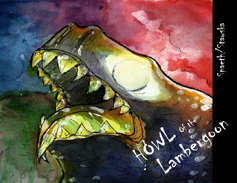
 |
Howl of the Lambergoon: Gad the Zig, Book 1
by Anthony Spaeth
illustrated by Marta Stawska
Meat For Tea Press
And there you visit Kraki’s tomb,
Remember the zig who dug his grave...
And howl for the lambergoon."
Hoon is a famous alchemist who once created a steaming draught for forgetting one’s troubles. Nowadays he must hide away from seeking customers in an island cave shared with Gad, his zig. The story opens with young Gad gathering clams by the seashore with his Shetland pony named Lull. Hoon and Gad have two surprise visitors at their mountain-side cave. First to arrive is the screeching lambergoon with its glowing eye who wishes to have a zig for dinner. Hoon’s magic cane and the bars of the cave sends away hungry the hideous monster who issues a challenge to Gad before departing. The next visitor arrives by boat—the daughter of King Flatnose who rules these seas. What causes her to bravely sail in search of the alchemist? Why did her father send her alone?
The story in this illustrated picture book for middle graders is a cross between “The Sorcerer’s Apprentice” (from a segment of the Disney movie Fantasia) and the award-winning book Where the Wild Things Are by Maurice Sendak. The gorgeous artwork throughout reminds one of video graphics onscreen or in graphic novels. Gad, the boy slave, vaguely resembles a squat POP! figure like those currently popular. A young reader could easily picture this story come to life either animated or with live action performers in a movie. The book’s subtitle hints at a sequel.
The epic poem made of short stanzas carries the narrative across 71 soft-cover pages, each being 10.5 inches by 8.5 inches. The text is printed in the outer margin on each page alongside a graphic (approximately 6.5 inches square) that shows the action. Four-line stanzas carry the narrative with typically one or two stanzas per page. Each stanza rhymes on the 2nd and 4th line, as shown in this sample verse:
The shadows grew beneath them.
The Wind turned out to sea.
The sun fell down the sky
To where the boiling waves must be.
Spaeth deserves kudos for his perseverance at rhyming this read-aloud book, and seldom does he allow the meter to slip. The reading level for this book is from 3rd to 6th grade. The author is conscientious at defining within the text any foreign or made-up words which are chosen clearly for poetic suitability. With no glossary, readers otherwise would have to guess that "jarls" are princes with swords on a daring adventure, "zigs" are slaves or servants to a famous person, and perhaps "berzerkers" are fierce Norse warriors.
Because of the story’s complexity, the artwork doesn’t always correspond directly to the text. A tattered, aging map of the Faroe Islands on the first page serves double duty. It sets the time frame for this tale and orients the reader through the narrative.
In most works for this age group, there is usually at least one moral to a story. In this book, there are two. Bravery is encouraged, as is dealing with past hurts instead of allowing them to cause continued pain and anxiety. It poses a question: What may have happened that we must forgive and forget?
RECOMMENDED by the US Review